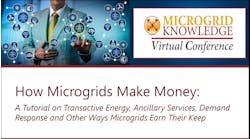The PJM Interconnection has begun a process to explore the role of utility connected microgrids in the organization’s wholesale power market.
The process “is part of a general effort to make sure PJM rules can accommodate all types of cases and resources and make sure there is nothing that prohibits incorporating microgrids,” Andrew Levitt, senior business solutions architect at PJM, told Microgrid Knowledge.
The issues PJM has identified will likely become even more pressing as microgrids continue to proliferate and, particularly, as microgrid developers seek to layer multiple revenue streams on to their business plans to help bring down capital costs.
The process is not the result of a request or order from the Federal Energy Regulatory Commission (FERC), which is responsible for regulating PJM’s wholesale power tariffs, but it is in “the same orbit” as FERC Order 841, Levitt, says. The process grew out of a few stakeholder requests and interest from both utilities and developers of distributed energy resources.
Order 841, issued in February 2018, directed grid operators to remove barriers to participation of electric storage resources in wholesale markets.
Defining utility connected microgrids
At present, PJM is not aware of any purposely built utility connected microgrids in its territory, though there could be some small generators in local load pickets that can “black start,” spokesman Jeff Shields said. There are already many single customer microgrids, however, and a few of them participate in PJM markets, he said.
Levitt is careful to note that PJM’s process is focused on microgrids that use utility owned wires to serve load during islanding, not on self-contained, single customer microgrids. When the latter go off grid, the customer is not buying from PJM and they are not serving PJM load. But when a microgrid uses utility distribution lines in an islanded state, “you begin to wonder if that is PJM load,” Levitt says.
It can be an important question because it brushes up against the jurisdictional issues that arise around the difference between state or retail electricity sales (local jurisdiction) and interstate or wholesale electricity sales (federal jurisdiction).
Asking the right questions
As it is, the term utility connected microgrids is not defined in PJM tariffs or manuals. At this stage of PJM’s process, the regional transmission organization (RTO) is engaging stakeholders and framing the questions that need to be addressed.
From an operations point of view, those questions include whether or not PJM can dispatch a utility connected microgrids to address distribution reliability needs. It is also unclear whether this kind of microgrid, when in islanded mode, is a “normal” generator that is available for dispatch and reserves. In a similar vein, it is also unclear if PJM should put restrictions on when a wholesale utility microgrid can operate in islanded mode. For instance, should the ability to island be restricted to only during a distribution system outage or during a PJM emergency situation that requires load shedding?
Utility connected microgrids also raise questions from a market and settlements point of view. For instance, can a microgrid generator participate in PJM Capacity Performance market — the grid operator’s new, enhanced capacity product? And, if so, how are PJM’s Performance Assessment Interval rules for Capacity Performance handled if the microgrid is in islanded mode? That also raises questions regarding whether or not an islanded microgrid should be considered part of RTO load.
And, more broadly, PJM is raising the question of whether additional market parameters should be considered for when a microgrid is in connected mode versus islanded mode.
PJM also sees gray areas that have yet to be explored from a planning perspective. One of the questions PJM has set out for exploration in this process is whether or not additional information requirements are needed to perform interconnection analysis. PJM is also is seeking to frame the question of what happens if another generator wants to connect to a distribution facility that is part of a utility connected microgrid.
Identifying interest within PJM
The stakeholder process regarding utility connected microgrids has just begun and does not yet have a firm time frame. At this stage in the process the goal is “interest identification” and “solution options” to formulate a consensus, Levitt says. As is typical for PJM, the process involves multiple rounds of meetings with stakeholders to formulate issues and to discuss and debate possible rule changes.
At this point, “I think it would be surprising” if any potential rule changes were published this year, Levitt said. Next year would be a more likely time frame for any new rules or procedures to be vetted, voted on and finalized, he said.
Track news about rules for utility connected microgrids. Subscribe to the free Microgrid Knowledge newsletter.







